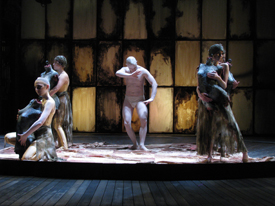
To many, the stories of Greek mythology are set in stone.
But don’t tell that to Izumi Ashizawa, assistant professor of movement and acting and the writer and director of Minotaur, currently being performed by this university’s theatre, dance and performance studies school.
Ashizawa has taken the story of Greek hero Theseus and pushed it into the era of Upton Sinclair’s The Jungle. The play interweaves the classic story with Chicago’s meatpacking industry in the 1920s.
It is in a slaughterhouse where we see Thes (Rob Jansen) slay a re-imagination of the minotaur, the Unbelievably Huge Man (Shane O’Laughlin), and escape to meet the daughter of the evil Slaughterhouse Tycoon Minos (Dave Demke), Ari (Claudia Rosales), whose long hair would put Rapunzel to shame.
It is after the classic battle against the minotaur that we begin our story, and it’s certainly where things get interesting.
Jansen plays Thes like a man possessed, pouring his soul into the character’s dark side as he cries of the “endless forest of carcasses.” We also get a gripping performance from Nick Horan’s crazed portrayal of Dion, the king of an island where Thes and Ari go to escape Minos. While the entire cast’s acting in Minotaur as a whole is authentic (and sometimes haunting), it is the scene between Thes and Dion that steals the show.
Just because the performances are strong doesn’t mean the play always makes sense. Ashizawa gives her audience a lot of credit — she doesn’t spoon feed the tale of Theseus to them. However, a small refresher (which you can get, for the most part, through the program notes) is helpful. Some moments, such as the story-within-the-story of the Scorpion SHE (Caroline Stefanie Clay) and the Hunting Boy (James Waters) or the story of the Old Man (Armando Batista) are not completely clear.
Even so, the story, for the most part, is comprehensible without prior knowledge — a significant improvement from Ashizawa’s last play at CSPAC, Gilgamesh.
There is a strong directorial connection to Gilgamesh: an emphasis on movement. One can tell Thes is cultured not just from the suit he wears but from the way he carries himself. Dion walks with his feet landing sideways and the slaughterhouse workers perform their duties with synchronized choreography.
There is one odd quirk in the direction. While most of it is over-the-top (and to great effect), some areas of the play seem hyper-sexualized. The women of Dion’s island (Teresa Ann Virginia Bayer, Olivia Brann, Anna Lynch, Whitney Rose Pynn and Anupama Singh Yadav) roll and crawl around the floor for several minutes in what seems to be orgasmic ecstasy around the Naked Chess Boy (Greg Mack). Also, Ari has a moment where she discusses death as a lover and touches herself in a sexual manner.
The moments are fascinating to consider, specifically in context — Ashizawa didn’t do this without reason — but it can also be distracting, and sometimes there is just too much of it.
Minotaur offers more than just strong performances. The set is dark and dank — the slaughterhouse becomes a character, always in the background of the story. The slaughterhouse is built with brick walls and wooden flooring with a pool of (obviously fake) blood that leaks down the side. As you walk in to the Kogod Theatre, make sure not to step in the resulting puddle.
Throughout the play, we see even more great technical aspects, such as cow hides riding on racks around the set and the fantastic costume used to make the Unbelievably Huge Man unbelievably huge.
The costumes for the rest of the cast are more or less spot-on. The period costumes are completely believable, such as Minos’ mafia-esque suit, the bloody aprons and uniforms of the slaughterhouse workers and Dion and the island women’s tattered shawls. There are also some clever uses of black bodysuits to disguise actors in the darkness.
The lighting designers also deserve commendation as light is used heavily and to great effect in the show. Strobe lights are effective, but so is dim lighting and darkness. At times, the entire set is pitch black. The carefully controlled lighting design casts the dank atmosphere of the slaughterhouse upon the theater.
There is no reason to beat around the bush. Minotaur is a strange show, but also dark and often entrancing. Brief moments of confusion are present, which is unfortunate because the play as a whole — from acting and costumes to set and light design — is quite strong.
Minotaur is also something new. The idea might be well-tread, but it still tells a strong story. More particularly, this version tells an old story in a new way, which provides for interesting liberties in the adaptation.
Is it strange? Absolutely, but it’s also fresh. Well, at least the play is — the slaughterhouse meat may not be.
Minotaur runs through April 23 at the Kogod Theatre in the Clarice Smith Performing Arts Center. Tickets are $27 for the public, $9 for students.
afreedman@umdbk.com



